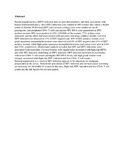Human papillomavirus infection and cervical abnormalities in Nairobi, Kenya, an area with a high prevalence of human immunodeficiency virus infection.

View/
Date
2008-05Author
Yamada, R
Sasagawa, T
Kirumbi, LW
Kingoro, A
Karanja, DK
Kiptoo, M
Nakitare, GW
Ichimura, H
Inoue, M
Type
ArticleLanguage
enMetadata
Show full item recordAbstract
Human papillomavirus (HPV) infection and cervical abnormalities, and their association with human immunodeficiency virus (HIV) infection were studied in 488 women who visited a health center in Nairobi. PCR-based HPV and cervical cytology tests were carried out on all participants, and peripheral CD4+ T cells and plasma HIV RNA were quantitated in HIV positive women. HIV were positive in 32% (155/488) of the women; 77% of these were untreated, and the others had been treated with anti-retroviral drugs within 6 months. Cervical HPV infection was detected in 17% of HIV negative and 49% of HIV positive women. Low-grade squamous intraepithelial lesions were observed in 6.9% of HIV negative and 21% of HIV positive women, while high-grade squamous intraepithelial lesions and cancer were seen in 0.6% and 5.8%, respectively. Multivariate analysis revealed that HIV and HPV infections were associated with each other. Cervical lesions were significantly associated with high-risk HPVs and with HIV infection, depending on HPV infection. HPV infection increased in accordance with lower CD4+ T cell counts and higher HIV RNA levels, and high-grade lesions were strongly associated with high-risk HPV infection and low CD4+ T cell counts. Immunosuppression as a result of HIV infection appears to be important for malignant progression in the cervix. Nationwide prevention of HIV infection and cervical cancer screening are necessary for the health of women in this area. High-risk HPV infection and low CD4+ T cell counts are the risk factors for cervical cancer.
URI
http://www.ncbi.nlm.nih.gov/pubmed/18360898http://erepository.uonbi.ac.ke:8080/xmlui/handle/123456789/57645
Citation
J Med Virol. 2008 May;80(5):847-55. doi: 10.1002/jmv.21170.Publisher
University of Nairobi College of Health Science
Collections
- Faculty of Health Sciences (FHS) [10378]
